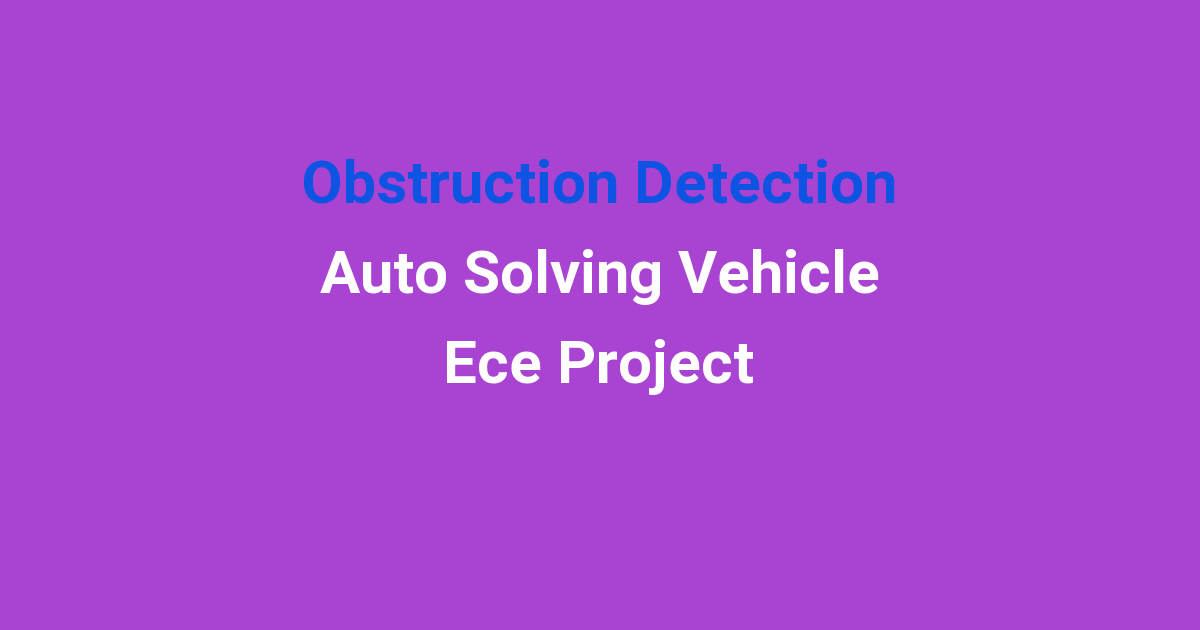ECE project on automatic obstacle detection and solving vehicle.
Obstruction Detection Auto Solving Vehicle ECE Project
Introduction
In today’s fast-paced world, advancements in technology have paved the way for innovative solutions to everyday problems. One such area where technology is making a significant impact is in the field of engineering, particularly in the development of autonomous vehicles. The concept of autonomous vehicles has gained traction in recent years, with major players in the automotive industry investing heavily in research and development to bring this vision to life.
One of the key challenges that autonomous vehicles face is detecting and navigating around obstructions in their path. This is particularly important in urban environments where unexpected obstacles can pose a threat to the safety of passengers and pedestrians. In this project, we aim to develop an Obstruction Detection Auto Solving Vehicle that utilizes cutting-edge technology to identify and overcome obstacles in real-time.
Problem Statement
The ability of an autonomous vehicle to detect and respond to obstacles is crucial for ensuring the safety of its occupants as well as other road users. Traditional obstacle detection systems rely on sensors such as cameras and LiDAR to detect objects in the vehicle’s path. However, these systems are not foolproof and can sometimes fail to accurately detect certain types of obstacles, such as low-lying objects or objects with irregular shapes.
In addition, existing obstacle detection systems often lack the ability to autonomously navigate around obstacles, instead relying on manual intervention from the driver or an external operator. This can be time-consuming and potentially dangerous in situations where quick decision-making is required.
Existing System
The existing system for obstacle detection in autonomous vehicles typically consists of a combination of sensors, including cameras, LiDAR, and radar, that work together to detect objects in the vehicle’s path. These sensors collect data about the vehicle’s surroundings and feed it to an onboard computer, which processes this information to identify obstacles.
While this system is effective in many cases, it has some limitations. For example, cameras can be affected by poor visibility conditions, such as fog or heavy rain, which can hinder their ability to accurately detect obstacles. In addition, LiDAR and radar systems can struggle to detect certain types of obstacles, such as low-lying objects or objects with irregular shapes.
Furthermore, the existing system lacks the ability to autonomously navigate around obstacles, relying instead on manual intervention from the driver or an external operator. This can be impractical in situations where quick decision-making is required, such as when navigating through busy urban environments.
Disadvantages
The disadvantages of the existing obstacle detection system in autonomous vehicles include:
1. Limited accuracy in detecting certain types of obstacles
2. Vulnerability to poor visibility conditions
3. Lack of autonomous navigation capabilities
4. Reliance on manual intervention for obstacle avoidance
Proposed System
In this project, we propose a novel Obstruction Detection Auto Solving Vehicle system that addresses the limitations of the existing system. Our system will utilize a combination of advanced sensors, including LiDAR, radar, and ultrasonic sensors, to detect obstacles in the vehicle’s path with high accuracy and reliability.
Furthermore, our system will incorporate machine learning algorithms to analyze sensor data in real-time and autonomously navigate around obstacles in the vehicle’s path. This will reduce the need for manual intervention and improve the vehicle’s ability to adapt to changing road conditions quickly.
Advantages
The advantages of our proposed Obstruction Detection Auto Solving Vehicle system include:
1. Improved accuracy in detecting obstacles
2. Enhanced reliability in all types of visibility conditions
3. Autonomous navigation capabilities for obstacle avoidance
4. Reduced reliance on manual intervention for obstacle avoidance
Features
Some key features of the proposed Obstruction Detection Auto Solving Vehicle system include:
1. Multi-sensor integration for comprehensive obstacle detection
2. Real-time data analysis using machine learning algorithms
3. Autonomous navigation around obstacles
4. Adaptive decision-making based on changing road conditions
Conclusion
In conclusion, the development of an Obstruction Detection Auto Solving Vehicle system has the potential to revolutionize the field of autonomous vehicles by addressing the limitations of the existing obstacle detection systems. By combining advanced sensors, machine learning algorithms, and autonomous navigation capabilities, our system will provide a safer and more reliable solution for navigating through urban environments. We believe that our project has the potential to make a significant impact in the field of engineering and contribute to the future development of autonomous vehicles.

